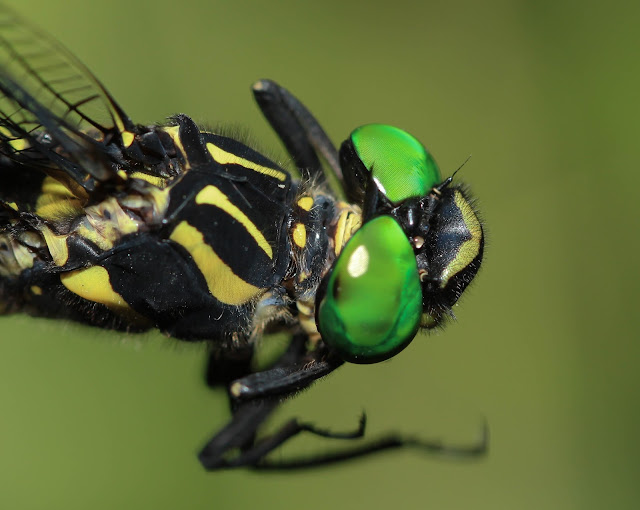Most of birders have a special ‘patch’ or two. A birding ‘patch’ is a place a birdwatcher visit regularly, know intimately and enjoy deeply. When I began chasing bugs in 2011, I maintained this practice.
On the lower slopes of Tam Dao, I have a dragonfly watching ‘patch’. It is a headwater stream of high quality, in secondary forest - but left unexploited for a long time. A wild and scenic stream with large boulders, small waterfalls, fallen trees… I know this place like the back of my hand - better perhaps. I come back again and again but I never get bored. There is always something new to discover.
Last June, I netted there a male Chlorogomphid making slow patrolling at a height of 0.5m to 1m above the stream. At this time its strongly protruded frons reminded me of Sinorogomphus nasutus, but the caudal appendages looked completely different.
When I returned home, a research on my documents (especially the paper “On the genus Cholorogomphus of Indochina with description of 6 new species and little known species” - Karube, 1995) revealed that it was a male Chlorogomphus sachiyoae.
Chlorogomphids are very similar and need to be examined in hand and identified using a combination of structural characters and general maculation pattern.
The male :
Head black with yellow markings, with frons obviously triangularly protruded. Labrum black with a medium yellow spot. Postclypeus yellow. Eyes almost meeting.
Pterothorax black with yellow stripes, with a narrow antehumeral, a broad humeral and a broad lateral stripes. This specimen shows also 2 spots at upper part of metepimeron, absent in Karube’s drawing of the holotype.
Abdomen black with yellow markings as follow : large spot at ventral of S1, two bands in S2, one oblique connected with the former spot and does not reach the dorsal top, the other one larger just before S3 and reach dorsal top (ring in dorsal view). Compare to the holotype’s drawing, these 2 bands in S2 are closer to each other and even - at one side of the body only - slightly connected.
Middle of S3 with a thin ring. S3-6 with dorso-apical spots, the one of S5 not well marked, the one of S6 the largest. S7-10 wholly black.
Caudal appendages: Cerci curved inwards, with stout oblique ventral spine (obvious in lateral view, but also quite visible in dorsal view), apex bilobed.
Wings, male.
The female :
Last year, few hundreds meters downstream, at about 250m a.sl., I netted a female Cholorogomphid at a 1m wide tributary. She was releasing eggs in flight over a shallow gravel section. At this time, I could not clinch the ID. But later, with the help of Karube's paper, I could confidently identify it as a female Ch. sachiyoae.
Abdominal markings similar to those of male but yellowish maculations of S2 more developed (the two bands are connected and enclose a black patch).
Head with coloration as in male; compare to male, frons less protruded and eyes more widely separated.
As Chlorogomphus albomarginatus and Ch. takakuwai, Ch. sachiyoae is, for instance, only known from Tam Dao* - pretty amazing! Apparently, it has never been recorded since its description in 1995.
*update June 2014 : this is no longer the case. Ch. sachiyoae has been recorded this year at different other sites in northern Vietnam.
I spotted the male at this 10m wide boulder river in forest at 300m a.s.l., fast-flowing in the steeper sections, with dense marginal vegetation. Other species encountered there include, amongst others, Archineura hetaerinoides, Atrocalopteryx coomani, Coeliccia onoi, C. scutellum, C. acco, Euphaea guerini, E. decorata, Philoganga vetusta, Rhinocypha orea (June 2014), Indocnemis orang, Devadatta ducatrix, Protosticta satoi, Agriomorpha fusca, Macromia pinratani vietnamica, Idionyx thailandica, Leptogomphus perforatus, Asiagomphus acco, Heliogomphus scorpio, Zygonyx iris… A pretty good ‘patch’ I think !
















Aucun commentaire:
Enregistrer un commentaire